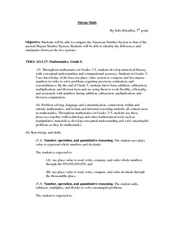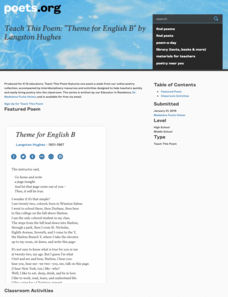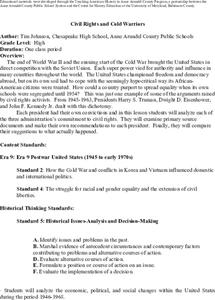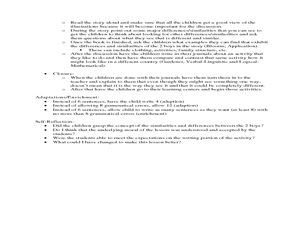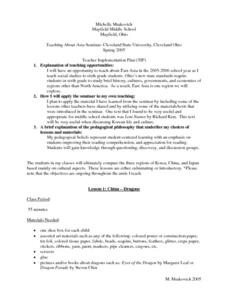Curated OER
Mayan Math
Fifth graders investigate the Maya's as mathematicians. In this Mayan math lessons, 5th graders work with the ancient Mayan numbering system by comparing it to the American Number System. They tell the differences and similarities...
Curated OER
Using News Broadcasts in Japan and the U.S as Cultural Lenses
Students view archives of news broadcasts in order to create a context of cultural understanding. They compare and contrast the news broadcasts in Japan and the United States.
Teaching Tolerance
Parallels Between Mass Incarceration and Jim Crow
Is history repeating itself? A riveting lesson examines the parallels between mass incarceration in the U.S. and the Jim Crow Laws of the past. Academics review Jim Crow Laws and compare them to mass incarcerations of African Americans....
Stanford University
Ruby Bridges
A two-part lesson features Civil Rights hero, Ruby Bridges. Part one focuses on the heroic actions of Ruby Bridges then challenges scholars to complete a Venn diagram in order to compare themselves to her. Part two begins with a...
Academy of American Poets
Teach This Poem: "Theme for English B" by Langston Hughes
Langston Hughes' "Theme for English B" is featured in a lesson plan that asks pupils to first read a biography of Hughes and list things about his life they think are important. The class then reads the poem and compares what they...
Curated OER
Russian Star Ornaments
Students research Russian Orthodox Christmas traditions in pre-soviet Russia and in other parts of the world. Then they create a handcrafted ornament in the style of old Russia. Students also decorate their Russian Star Ornament with...
National Museum of the American Indian
Fritz Scholder: A Study Guide
In this engaging activity involving close analysis of abstract expressionist art, your class members will not only discover more about artist Friz Scholder's Native American art, but they will also have the opportunity to consider...
John F. Kennedy Center
Musical Harlem: How Is Jazz Music Reflective of the Harlem Renaissance?
Bring jazz music and the Harlem Renaissance to light with a lesson that challenges scholars to research and create. Pupils delve deep into information materials to identify jazz terminology, compare types of jazz and jazz musicians,...
K20 LEARN
Tribal Sovereignty and the Indian Reorganization Act: Tribal Governments
Sovereign nations or wards? High schoolers investigate the history of the Indian Reorganization Act and other legislation that impacted Native Americans. They also research different tribes' constitutions, compare them to the U.S....
Math Flix
MathFLIX Challenge: Multiplying and Dividing Fractions
First, math majors compare the multiplication and division of unit fractions and whole numbers. They look for patterns, and then apply their knowledge to an array of multiplication and division problems, all involving fractions and...
Curated OER
Reading Tables
Who is two years younger than Meg? Who is older than Paul, but not Kinta? Scholars practice reading tables as they answer comprehension questions based on three sets of data. First, they examine a table depicting ages, then favorite...
Council for Economic Education
Why Didn't China Discover the New World?
Who was Zheng He and why haven't we heard of him? Scholars consider the question as they compare his vast expeditionary force to that of Christopher Columbus. Young historians then ponder the intersection of science, economics, and...
Center for History Education
Civil Rights and Cold Warriors
Three presidents, three views on civil rights. Scholars compare the administrations of President Truman, Eisenhower, and Kennedy to understand how each addressed the issue of civil rights. The lesson plan uses primary sources and graphic...
DocsTeach
School Desegregation Court Cases: Mendez v. Westminster and Brown v. Board
Separate is not equal! Young historians analyze the petition from the U.S. Supreme Court case Mendez v. Westminster filed in 1945 and examine background material about the case. They then compare it to the more famous Brown v. Board of...
Curated OER
Finding My Hat
Sixth graders explore the Korean culture through the book, Finding My Hat. They read and discuss the book in literature circles and write in response journals after each chapter. Comparing the main character to themselves, they note the...
Curated OER
Compare and Contrast the French Cinderella with Other Cultural Versions
Learners first compare and contrast the traditional French Cinderella with Cinderella stories from around the world as well as the opera synopsis. Students write their own Cinderella stories, personalizing them with aspects from their...
Curated OER
Analyzing the economic, political, social, and cultural transformation of the United States since World War II
Eleventh graders examine political issues in the United States between 1936 and 2000. In this American history lesson, 11th graders study the economy, education, government, civil rights, and sports of this time period. Students compare...
Curated OER
Multiple Viewpoints
First graders explore the concept of multiple viewpoints. In this perspective instructional activity, 1st graders discuss the differences and similarities found within different cultures. Students then write a narrative about how...
Curated OER
Cultural Lit. 31: The U.S. and Iroquois Constitutions
Students identify and compare major elements of Iroquois and United States Constitutions.
Curated OER
Bring on the World: Football Around the World
Students explore the existence of football in the world. In this current events lesson, students examine how football is played using an interactive whiteboard. Students compare its existence in the United Kingdom and in African nations.
Curated OER
China - Dragons
Students compare cultural practices, products, and perspectives to understand commonality and diversity among cultures. They analyze examples of interactions between cultural groups and explain factors that contribute to cooperation...
Curated OER
Where Is Japan? How Are We Alike And Different?
First graders use literature, maps, and globes to explain how physical environments in various parts of the world are similar to and different from one's own, and that certain areas have common characteristics and can be called regions.
Curated OER
Egypt's golden Empire
Students explore many of the key scientific and technological contributions made by the ancient Egyptians. Researched data is presented to the entire group.
Curated OER
Great Cities of the Middle East
Students explore the cities of Cairo, Istanbul, Jerusalem, Mecca and Tehran. In this Middle East lesson plan, students complete a map, research one of the five the cities and prepare a presentation that includes details about the...
